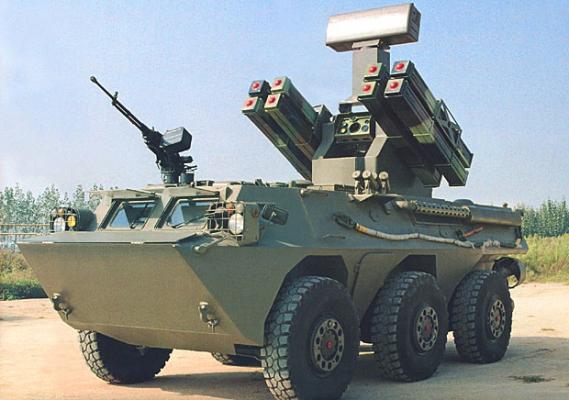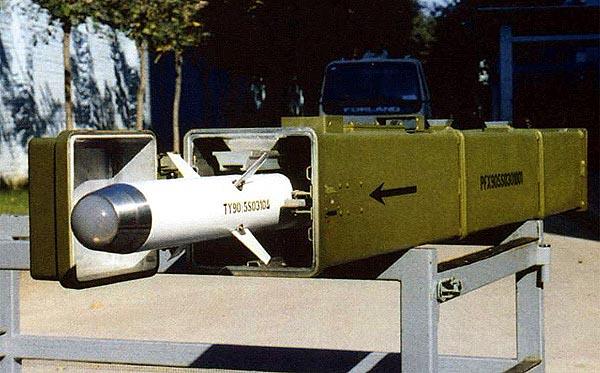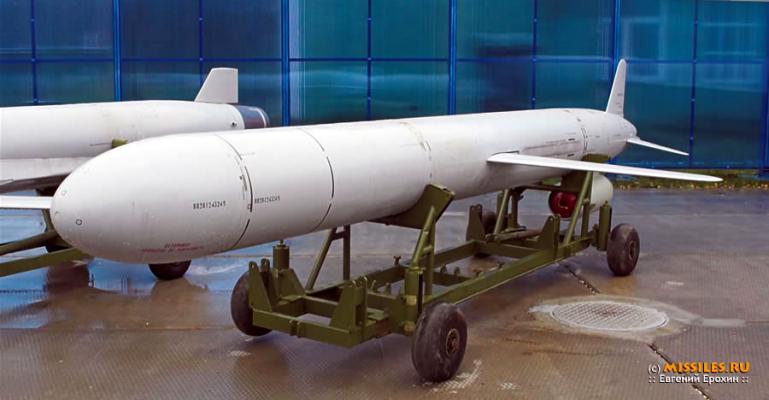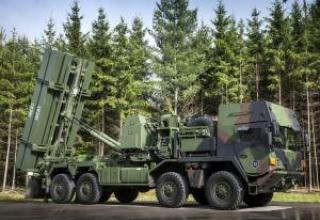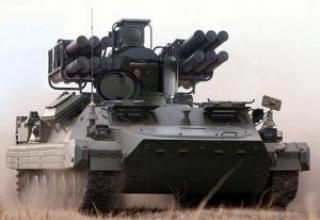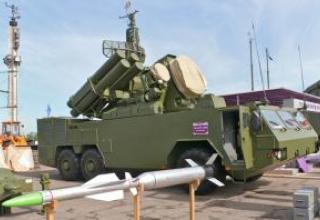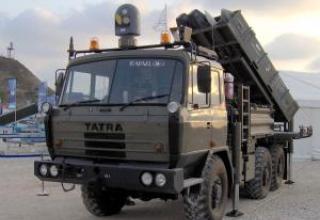Near-range anti-aircraft missile system "Yitian" ("Ityan") is designed to protect troops on the march and stationary objects from low-flying aircraft and helicopters of army aviation, as well as the destruction of drones and cruise missiles of the enemy at any time of day, in difficult weather conditions.
As a means of defeat in the SAM "Yitian" used modernized missile TY-90 class "air-to-air", developed in China in the late 90's for the armament of attack helicopters. The construction scheme and concept of the complex is similar to SANTAL, Avenger and other systems of similar purpose. However, according to the developers, the Yitian SAM system has a higher combat efficiency due to the fact that it is equipped with a TY-90 missile with a higher power combat unit compared to the Stinger missile, which is part of the American systems.
Due to its modular design, the complex can be mounted on various models of wheeled or tracked armored vehicles. Yitian" SAM system was first shown at the end of 2004 and since then it has been repeatedly demonstrated at international exhibitions in various versions. At IDEX 2009 (United Arab Emirates), China North Industries Corporation (NORINCO) presented two versions of the complex - based on the wheeled armored vehicle WMZ 551 and on the chassis of all-wheel drive off-road vehicle EQ2050. There is also known towed version of the launcher "Yitian", made on a semi-trailer and part of the anti-aircraft missile and artillery system (SAM) "Giant Bow-II".
Composition:
The complex consists of:
- TY-90 anti-aircraft guided missiles,
- 3-D radar X-band detection station,
- an optronic detection and tracking station,
- equipment for rocket testing and maintenance.
When placed on the base of the WMZ 551 wheeled armoured personnel carrier (6x6 wheel arrangement), a unified combat turret of circular rotation is installed in the middle part of the vehicle, right behind the engine compartment. Two bags of four transport and launch containers (TY-90 ZUR) are placed at the sides of the turret. Optical-electronic station is located between the packets of TY-90 and includes: optical range sight, thermal imager, automatic target tracking device and laser rangefinder, which allows you to detect, capture and automatically follow the air targets. The detection radar antenna is placed on the roof of the tower and folded in a camping position (see photo). The crew of the combat vehicle consists of 3 persons: a commander, a driver mechanic and an air defense system operator. The commander and driver are located at the front of the vehicle, while the operator is in the turret. For self-defense, the vehicle is equipped with a 12.7 mm W-85 machine gun mounted on the turret above the driver's hatch, and two 4-barreled smoke grenade launchers. The combat vehicle is equipped with a navigation system, a filter and ventilation unit and an auxiliary power unit, which ensures the serviceability of the complex at stops. The weight of the Yitian SAM system is 16 tons. BM is equipped with an air-cooled diesel engine "Deutz" BF8L413F 320 hp and has a maximum speed of 100 km / h on the highway and a range of 800 km. The BM has retained the ability to drive on water, but due to the extra weight in the top of the machine has a rather limited amphibious capacity compared to the basic chassis.
The radar has a target detection range of 18 km for a fighter target and 8 km for a cruise missile target, while the automatic tracking range is 10 km. The maximum detection range of a fighter by means of an optronic station is up to 12 km and depends heavily on weather conditions. Target detection and destruction is as follows. After target detection and detection by means of a surveillance radar, the tower system with the missiles turns azimuthally towards the target. The operator searches for the target using a thermal imaging camera or an optical sight. When a target is detected, it is automatically captured by an escort, and when a target enters the area of engagement, the missiles are launched. The system reaction time is 6...8 seconds. Maximum speed of the target to be hit is up to 400m/s. Recharging is carried out manually.
ZUR TY-90 is made according to the scheme "duck" with non-folding aerodynamic surfaces. It is equipped with an all-angle infrared homing head, specially designed to capture the target in conditions of interference created by the underlying surface and ground objects. The launch weight of the missile is about 20 kg. Shrapnel and high-explosive warhead with a mass of 3 kg. Solid fuel jet engine reports speed up to 2M for the missile.
The SAM is designed to operate as part of a tactical air defense system, but can operate independently. The target designation system can be received from its own detection radar or other sources. A typical Yitian SAM system battery includes a battery command post, 6 combat vehicles, supply, inspection and maintenance vehicles. The battery may be provided with an additional survey radar. The battery command post is also located on the chassis of the WMZ 551 armoured personnel carrier with an IBIS-80 type view and detection radar at the rear. The IBIS-80 radar with fast frequency conversion can detect up to 40 air targets, 12 of which are to be escorted.
When installed on all-wheel drive off-road vehicle EQ2050 by Dun Feng Motor, the combat module of Yitian SAM system is located on a turntable platform in the body of the vehicle behind the cab (see photo). The combat module has a lower height due to the location of the radar antenna and the optronic station between the transport and launch container packs. However, the system has lost the possibility of continuous all-round visibility and target detection is possible only in a specific sector where the module is turned. The operator's seat is located in the cab on the right.
The anti-aircraft missile and artillery system "Giant Bow-II" (see photo) provides for combined use of TY-90 SAM system with a towed launcher and 23 mm Type 87 artillery pieces. (modification of Soviet ZU-23-2). In this case, the system is controlled centrally from the point of guidance and control, located on the basis of all-wheel drive army truck EQ240 (6x6). The anti-aircraft missile launchers are mounted on a towed carriage from the Type 87 artillery. The missiles are launched from beam rails, guided in two planes. Three-dimensional radar for all-around visibility and target tracking AS901A is mounted on the chassis of the car "BJ2020" (4x4).
Characteristics:
| Range of fire, m: - minimum - maximum |
500 6000 |
| Height reachable, m: - minimum - maximum |
15 4000 |
| Target detection/convoy range, m: - radar station - electro-optical station |
18/10 12/8 |
| Dimensions of PM based on WMZ 551, mm: - length - width - clearance |
6630 2800 467 |
| Missile launch weight, kg | 20 |
| Weight of combat unit, kg | 3 |
| It's marching speed, M. | 2 |
| Maximum permissible overload, g | 20 |
| The dimensions of the TY-90 missile, mm: - length - diameter |
1950 90 |
Testing:
The first flight of the prototype carrier aircraft Tu-95M-55 (BM-021) took place on July 31, 1978. A total of 107 flights and launches of ten X-55s were made on this machine by the beginning of 1982. The plane was lost in the crash January 28, 1982 on takeoff from Zhukovsky because of pilot error.
The tests of the X-55 were very intensive, which was facilitated by a thorough pre-testing of the control system on the model stands of NIIAS. During the first stage of the tests 12 launches were conducted, only one of which failed due to the power system generator failure. In addition to the missile itself, the weapon control system was brought to the surface of the launch vehicle, which was used to launch the mission and exhibit the missile's gyroinertial platforms.
The first launch of the serial X-55 was made February 23, 1981. September 3, 1981 the first set-off launch was made with the first production car Tu-95MS. Tests of the complex were conducted on the route measuring complex of the 929th LIC. Test launches of X-55 were carried out virtually the entire range of flight modes of the carrier from altitudes of 200m to 10km. The engine was launched reliably, the speed on the route, adjustable depending on weight loss during fuel production, was maintained in the range of 720-830 km/h. With a given value of CVO not more than 100m in a number of starts a deviation of only 20-30m was achieved.
The first to master the new complex started in Semipalatinsk 1223rd TBAP, which on December 17, 1982. arrived two new Tu-95MS. Since 1984, retraining on the Tu-95MS began adjacent 1226th TBAP of the same Semipalatinsk 79th TBAD. At the same time there was equipping of Tu-95MS regiments YES in the European part of the USSR - 1006 TBAP in Uzin near Kiev and 182nd TBAP in Mozdok, which was part of the 106th TBAD. In the division were concentrated more advanced Tu-95MS-16. The first Tu-160 arrived in April 1987 in the 184th TBAP, which was located in Priluki in Ukraine. Three months later, August 1, 1987 the crew of regiment commander V.Grebennikov first performed the launch of X-55.
After the collapse of the USSR, most of the X-55 missiles and their carrier aircraft remained outside Russia, in particular, in Kazakhstan and Ukraine, where there were, respectively, 40 Tu-95MS in Semipalatinsk, 25 in Uzin and 21 Tu-160 in Priluki. Together with the aircraft in the Ukrainian bases remained 1068 missiles X-55. With Kazakhstan, we managed to agree quickly enough, exchanging heavy bombers for proposed Russian fighters and attack aircraft. By February 19, 1994 all TU-95MS were ferried to the Far Eastern airfields, where they were equipped with the 182nd and 79th TBAP. The negotiations with Ukraine lasted a long time. Eventually, three TU-95MS and eight TU-160, which flew to Engels in February 2000, were transferred by the Ukrainian side on account of debts for gas. At the end of 1999, 575 air-based cruise missiles X-55 and X-55SM were also delivered from Ukraine to Russia.
In the Russian Air Force, all the forces of the YES were combined into the 37th Air Force. In its composition by July 2001, there were 63 Tu-95MS aircraft with 504 missiles Kh-55, as well as 15 Tu-160. The first practical launch of X-55SM from the Tu-160 was made by the crew of Colonel A. Zhikharev October 22, 1992. In June 1994, four Tu-95MS and Tu-160 took part in the exercises of the Russian Strategic Nuclear Forces, having worked out tactical launches over the North Sea and then executed the actual firing of X-55SM at the range. In September 1998, a group of four Tu-95MS 184th TBAP were made launches of X-55 in the area of the Northern Fleet training ground Chizha, where the missiles were 1500 km to the target.
During the exercise "West 99" in June 1999, a pair of Tu-95MS from Engels performed a 15-hour flight, reaching Iceland, and on the way back made a launch of X-55 on a training target in the Caspian Sea. In October 2002, the crew of the Tu-160 Colonel Yu Deineko in a night flight passed the route over the circumpolar areas, performing a practical launch of X-55SM. May 14, 2003 the four Tu-95MS and six Tu-160 participated in exercises covering the Persian Gulf and the Indian Ocean. Launches of the X-55 from the Tu-95MS were held during the strategic command training of land, sea and air SNF in February 2004.
Sources:
- TY-90 (Yitian) Surface-to-Air Missile /www.sinodefence.com/
- Зенитная ракетная система «Итянь» (TY-90)
